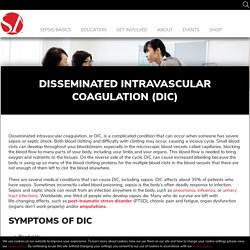

Sepsis In The Age of COVID-19 (April 10, 2020) Long Term Effects -- COVID-19 and Sepsis. Disseminated Intravascular Coagulation (DIC) Disseminated intravascular coagulation, or DIC, is a complicated condition that can occur when someone has severe sepsis or septic shock.

Both blood clotting and difficulty with clotting may occur, causing a vicious cycle. Small blood clots can develop throughout your bloodstream, especially in the microscopic blood vessels called capillaries, blocking the blood flow to many parts of your body, including your limbs and your organs. This blood flow is needed to bring oxygen and nutrients to the tissues. On the reverse side of the cycle, DIC can cause increased bleeding because the body is using up so many of the blood clotting proteins for the multiple blood clots in the blood vessels that there are not enough of them left to clot the blood elsewhere. There are several medical conditions that can cause DIC, including sepsis. Symptoms of DIC Blood clotsBruising, mottling of the skinDrop in blood pressureBleeding, from many sites in the body Treatment of DIC Complications from DIC.
Canadian team treating COVID-19 patients with dialysis sees 'very positive' early signs. TORONTO -- A team of Canadian researchers trying to treat seriously ill COVID-19 patients with a modified form of dialysis is seeing promising signs that they are able to fend off deadly immune system responses to the novel coronavirus.

"So far, the responses have been very positive – but obviously it's very early days," Dr. Chris McIntyre, who leads the team at the Lawson Health Research Institute in London, Ont., told CTV's Your Morning on Wednesday. The researchers are believed to be the first in the world to look at using dialysis machines, which are commonly available in intensive care units (ICUs) to treat patients whose immune system responses to COVID-19 include severe inflammation. This inflammation is one sign of a phenomenon known as a "cytokine storm. " It is normal for the human body to produce cytokines to fight off infection and then stop once the virus or bacterium has been defeated. Septic shock: Prevention, treatment, and causes.
Septic shock is a severe and potentially fatal condition that occurs when sepsis leads to life-threatening low blood pressure.

Sepsis develops when the body has an overwhelming response to infection. Knowing how to recognize and prevent septic shock is vital. The body usually responds to an infection by releasing inflammatory substances into the bloodstream. These regulate the immune system to fight the infection. When the body loses control of this response, it triggers damaging changes to the organs. If a person with sepsis has low blood pressure that does not improve with fluid treatment, this means that their body has gone into septic shock. Without this treatment, insufficient blood flow can result in vital organs not getting enough oxygen and beginning to fail, such as the brain, kidneys, lungs, and heart. Sepsis is often fatal. This article discusses how to understand the signs and symptoms of septic shock and how to prevent it. Sepsis. Life-threatening organ dysfunction triggered by infection Sepsis is a life-threatening condition that arises when the body's response to infection causes injury to its tissues and organs.[5] This initial stage is followed by suppression of the immune system.[9] Common signs and symptoms include fever, increased heart rate, increased breathing rate, and confusion.[2] There may also be symptoms related to a specific infection, such as a cough with pneumonia, or painful urination with a kidney infection.[3] The very young, old, and people with a weakened immune system may have no symptoms of a specific infection, and the body temperature may be low or normal instead of having a fever.[3] Severe sepsis is sepsis causing poor organ function or blood flow.[10] The presence of low blood pressure, high blood lactate, or low urine output may suggest poor blood flow.[10] Septic shock is low blood pressure due to sepsis that does not improve after fluid replacement.[10] Signs and symptoms[edit]

Systemic inflammatory response syndrome. Inflammation affecting the whole body in response to an infectious or noninfectious insult Systemic inflammatory response syndrome (SIRS), is an inflammatory state affecting the whole body.[1] It is the body's response to an infectious or noninfectious insult.

Although the definition of SIRS refers to it as an "inflammatory" response, it actually has pro- and anti-inflammatory components. Presentation[edit] Complications[edit] SIRS is frequently complicated by failure of one or more organs or organ systems.[2][3][4] The complications of SIRS include. Long Term Effects (COVID-19) Colchicine (COVID-19) Treatment & Prevention (COVID-19)